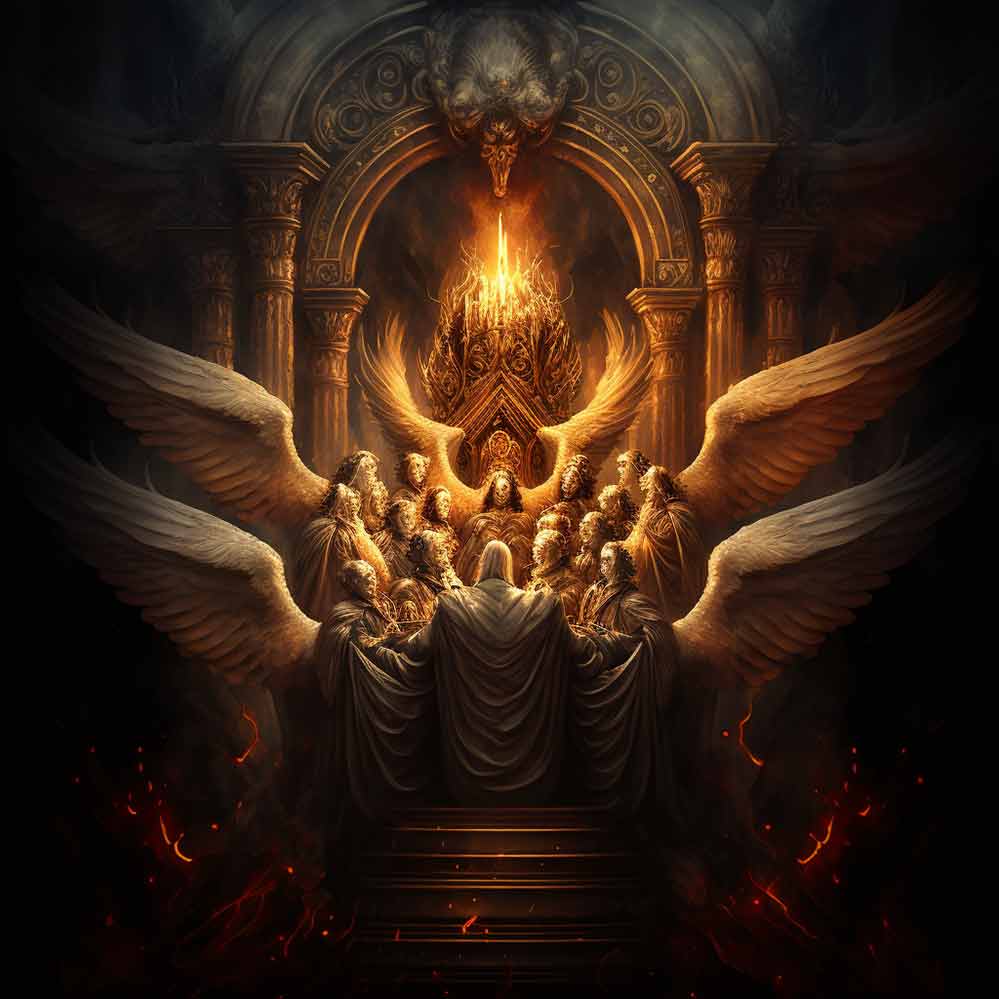The Seraphim transcend mere messengers or guardians; they are the ultimate bearers of God’s light and the perpetual singers of His heavenly glory. Known as “the burning ones,” their brilliant presence and six magnificent wings symbolize their intense purity and the fervor of their endless worship of God.
What are Seraphim?
Seraphim are one of the highest-ranking angels in Christian theology, often portrayed in religious art and literature. The term “Seraphim” is plural, with “seraph” being the singular form. They are described in the Bible, particularly in the book of Isaiah. According to Isaiah 6:1-7, seraphim stand above the throne of God, and they are depicted as having six wings: two cover their faces, two cover their feet, and with two they fly.
The name “Seraphim” means “the burning ones” or “ones of fire” in Hebrew, reflecting their association with purity and the intensity of their devotion and presence near God. Their primary role is to worship God and proclaim His glory, constantly singing praises such as “Holy, holy, holy is the Lord of hosts; the whole earth is full of his glory.”
In Christian angelology, seraphim hold a particularly high status, serving as a symbol of God’s light and purity. They are often involved in mystical experiences and visions reported by saints and theologians, where they act as messengers of God’s wisdom and truth.
Besides their religious significance, seraphim have also been subjects in various forms of art, literature, and music, depicted as creatures of light and fire, embodying spiritual inspiration and divine authority. Their representation across different media underscores their profound impact on Christian spirituality and artistic expression.
How are Seraphim Portrayed in Art and Culture?
Seraphim are frequently depicted in religious art and cultural expressions, where they embody themes of purity, holiness, and the divine presence. Here are some common portrayals and representations of seraphim in art and culture:
- Visual Art: In Christian iconography, seraphim are often depicted with six wings, adhering to the description found in the Book of Isaiah. They usually appear in scenes that are heavily religious, such as those depicting the throne of God or heavenly visions. In these artworks, seraphim may be shown covering their faces and feet with their wings, symbolizing their reverence and humility in the presence of God. The wings are frequently adorned or rendered in fiery colors, emphasizing their name’s meaning, “the burning ones.”
- Literature: Seraphim appear in various theological and spiritual texts where they are discussed not only in terms of their biblical roles but also as symbols of the highest state of angelic beings. They are often portrayed as mediators of divine light and wisdom, embodying God’s grace and majesty.
- Music: In the realm of sacred music, references to seraphim can be found in hymns and choral works that are used in liturgical settings. Composers like Hildegard von Bingen and others have written pieces that evoke the celestial and fiery nature of seraphim, using music to capture their ethereal and holy essence.
- Popular Culture: While their portrayals are less common in mainstream media compared to other types of angels, seraphim occasionally appear in films, books, and games where angelic beings are characterized. In these contexts, seraphim are often depicted as powerful and awe-inspiring creatures, emphasizing their high rank and close proximity to the divine.
- Architecture: In many cathedrals and churches, seraphim can be seen in stained glass windows, murals, and sculptures. These artistic elements often serve not only as decoration but also as theological teachings, presenting seraphim in a way that encourages reflection on the divine.
Overall, the portrayal of seraphim in art and culture reflects their significant role as embodiments of divine fire and messengers of God’s supreme power. Their depictions serve to inspire awe and reverence for the divine, aligning closely with their biblical descriptions and theological significance.
The Role of Seraphim Angels
Seraphim serve distinctive and critical roles that underline their importance in religious narratives and doctrines. Their responsibilities can be summarized as follows:
- Worship and Praise: The primary role of the seraphim is to worship God continually. This is vividly depicted in the Book of Isaiah (Isaiah 6:1-3), where seraphim are seen hovering around the throne of God, singing “Holy, holy, holy is the Lord Almighty; the whole earth is full of his glory.” This act of worship emphasizes their role in upholding God’s majesty and sanctity, serving as a perpetual reminder of His divine supremacy and glory.
- Purification: In the same biblical account, a seraph purifies the prophet Isaiah by touching his lips with a burning coal taken from the altar of Heaven, symbolically cleansing him of sin and unworthiness. This act illustrates the seraphim’s role in purification and sanctification, helping prepare humans for divine encounters and service by cleansing them from impurities.
- Messengers of God: While the role of messenger is more commonly associated with other types of angels like archangels, seraphim too communicate God’s will and wisdom, especially in matters of great theological importance and mystery. Their close proximity to God equips them with profound insights and truths, which they can impart to humans chosen for divine revelations.
- Bearers of Light and Love: Symbolically, seraphim represent God’s light and love due to their fiery nature and their service near the throne of God. They are often seen as bearers of this divine light, illuminating the darkness of ignorance and sin, and promoting the warmth of divine love and compassion.
- Guardians of God’s Throne: While not explicitly stated, their presence around the throne and their intense participation in divine worship suggest that seraphim also serve as guardians of the divine throne. This role aligns with their portrayal as beings of immense power and holiness, positioned to uphold and protect the sanctity of God’s presence.
Through these roles, seraphim contribute profoundly to the celestial hierarchy and the functioning of the divine order. They are not only servants but also powerful symbols of God’s holiness, purity, and eternal governance over the universe. Their depiction in theology and art continues to inspire and reflect the deep-seated human longing for connection with the divine.
The Specific Powers of Seraphim
Seraphim, as described in Christian theology, possess specific powers that highlight their esteemed position in the celestial hierarchy. These powers are not only reflective of their divine status but also serve functional purposes in the theology of angels. Here’s a detailed look at the specific powers attributed to seraphim:
- Purification: One of the most notable powers of seraphim is their ability to purify. This is exemplified in the biblical narrative of Isaiah, where a seraph purifies the prophet’s lips with a live coal from the altar, symbolizing the cleansing of sin and enabling direct communication with God. This act of purification is central to their role in preparing and sanctifying individuals for divine service and encounters.
- Illumination and Enlightenment: Seraphim are believed to possess the power to enlighten and illuminate the minds of humans. Given their close proximity to God and their constant involvement in divine worship, they are thought to have access to deep, divine knowledge which they can impart to human beings. This includes insights into divine mysteries and the revelation of God’s truth.
- Incendiary Presence: Reflecting their name, which means “the burning ones,” seraphim are associated with fire. This fire symbolizes both the light of God and the purifying power of His love. The fiery aspect of seraphim is not just literal but also metaphorical, representing their ability to ignite faith and devotion in believers.
- Worship and Adoration: While this may not seem like a ‘power’ in the conventional sense, the seraphim’s ability to continuously worship God is a potent spiritual act. Their worship is said to sustain the heavenly chorus of praise and reflects the glory of God back upon Himself, magnifying His sanctity and majesty.
- Guardianship: Though primarily depicted as worshippers and purifiers, the formidable presence of seraphim around the throne of God suggests a role in guarding the divine. This guardianship is tied to their overwhelming holiness and power, positioning them as defenders of the divine order and sanctity.
These powers enable seraphim to execute their duties effectively, reinforcing their status as one of the most powerful and revered orders of angels in Christian angelology. Through these roles and powers, seraphim contribute to the maintenance of the celestial order and the execution of divine will, making them essential figures in the spiritual cosmology.
Do Seraphim Interact with Humans?
Seraphim, while primarily associated with the highest realms of heaven and the direct worship of God, do have instances of interaction with humans according to Christian theology, albeit these instances are relatively rare compared to other types of angels. Their interactions with humans are usually significant and deeply spiritual in nature. Here’s a closer look at how seraphim interact with humans:
- Visions and Revelations: The most well-documented interaction between seraphim and humans occurs in prophetic visions, as is famously described in the Book of Isaiah, chapter 6. In this vision, Isaiah sees seraphim around the throne of God, singing praises and one of them touches his lips with a burning coal to purify him. This act enables Isaiah to speak prophetic truths and is a profound example of a seraph’s interaction with a human, aimed at preparing Isaiah for his prophetic mission.
- Spiritual Purification: As seen in Isaiah’s encounter, seraphim can purify individuals, which is crucial in preparing them for divine service or deeper spiritual experiences. This purification is symbolic and literal within the context of the vision, indicating a transformation that allows a closer relationship with the divine.
- Transmission of Divine Wisdom and Insight: While not as frequently mentioned as other angels like Gabriel or Michael, seraphim can act as conveyors of deep theological truths and divine wisdom, given their close proximity to God and their understanding of divine mysteries. These interactions, however, tend to be less direct and more mystical, often occurring through spiritual experiences rather than clear, direct dialogue.
- Inspirational Presence: The presence of seraphim is believed to inspire those who are spiritually attuned to their existence. This is more of an indirect interaction but is significant in influencing humans towards greater faith, devotion, and spiritual awakening.
While seraphim are not everyday messengers or guardians like some other angelic beings, their interactions with humans are impactful, deeply transformative, and tied to significant moments of spiritual revelation and development. The nature of their interactions underscores their role as beings of pure worship and divine proximity, involved with humanity primarily at pivotal moments of spiritual significance.









